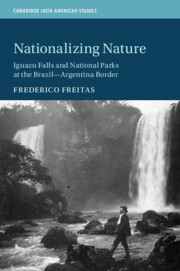Book contents
- Nationalizing Nature
- Cambridge Latin American Studies
- Nationalizing Nature
- Copyright page
- Dedication
- Contents
- Figures, Maps, and Tables
- Acknowledgments
- Note on Terminology and Orthography
- Introduction: Boundaries of Nature
- 1 Nationalizing the Border
- 2 Playing Catch-Up
- 3 A Park and a Town
- 4 Land Conflict
- 5 Surveillance and Evasion
- 6 The View from Above
- Epilogue: The Resilience of Boundaries
- Bibliography and Sources
- Index
- Other Books in the Series (continued from page ii)
Epilogue: The Resilience of Boundaries
Iguazú and Iguaçu National Parks, 2020
Published online by Cambridge University Press: 08 March 2021
- Nationalizing Nature
- Cambridge Latin American Studies
- Nationalizing Nature
- Copyright page
- Dedication
- Contents
- Figures, Maps, and Tables
- Acknowledgments
- Note on Terminology and Orthography
- Introduction: Boundaries of Nature
- 1 Nationalizing the Border
- 2 Playing Catch-Up
- 3 A Park and a Town
- 4 Land Conflict
- 5 Surveillance and Evasion
- 6 The View from Above
- Epilogue: The Resilience of Boundaries
- Bibliography and Sources
- Index
- Other Books in the Series (continued from page ii)
Summary
Iguazú and Iguaçu National Parks, 2020. In the 1980s, UNESCO listed Iguazú and Iguaçu National Parks, separately, as World Heritage Site. This epilogue argues that ideas about national sovereignty and transboundary antagonism continued guiding the way park officials in the two countries framed the parks. That explains why Brazilians and Argentines ignored calls for co-management and greater integration by UNESCO officials. All in all, the two Iguazu parks were never “peace parks” as integrated adjacent transboundary parks are called.
Keywords
- Type
- Chapter
- Information
- Nationalizing NatureIguazu Falls and National Parks at the Brazil-Argentina Border, pp. 279 - 285Publisher: Cambridge University PressPrint publication year: 2021

